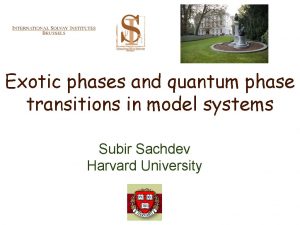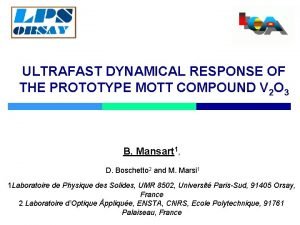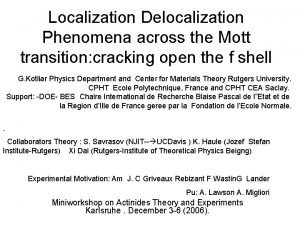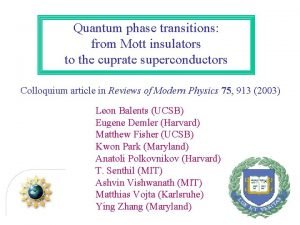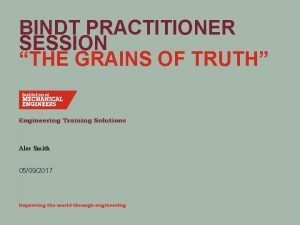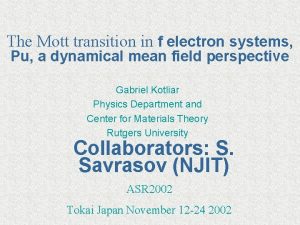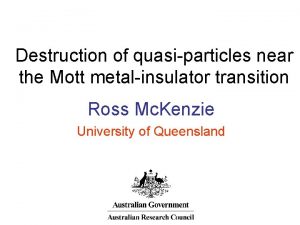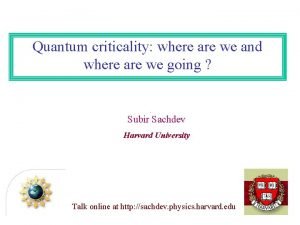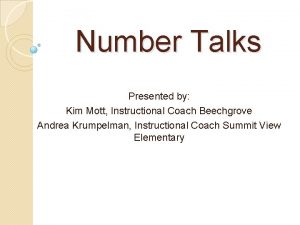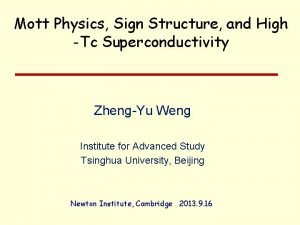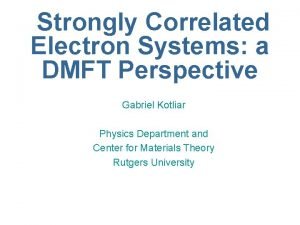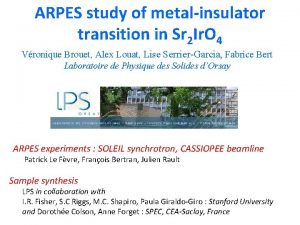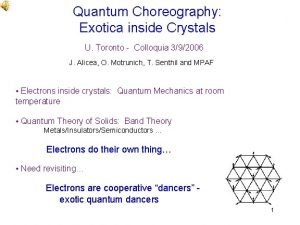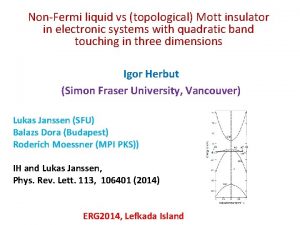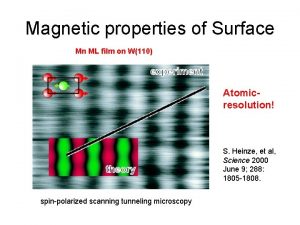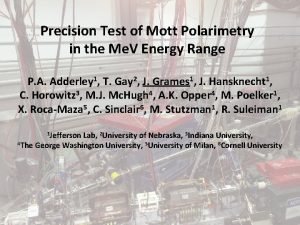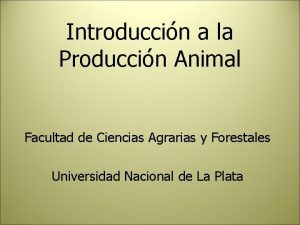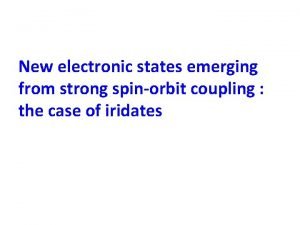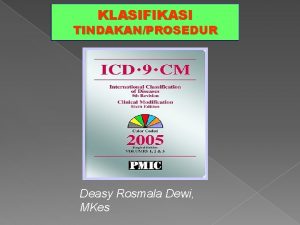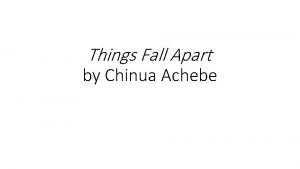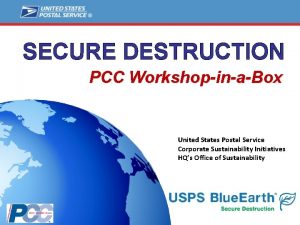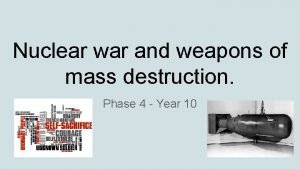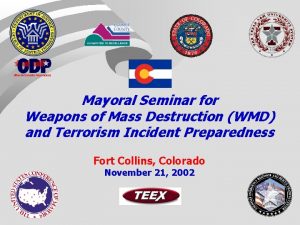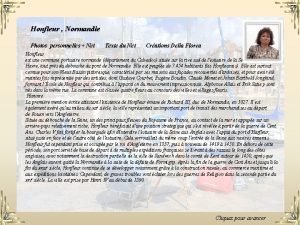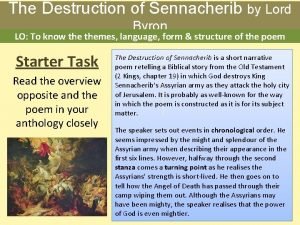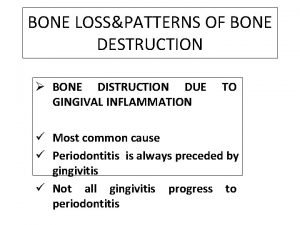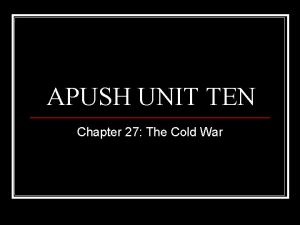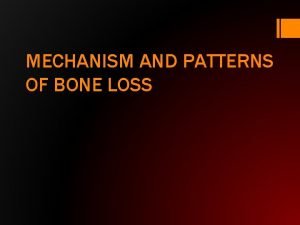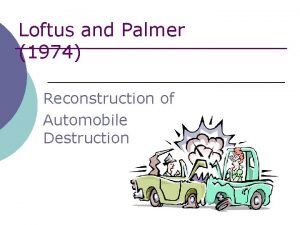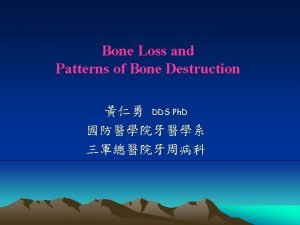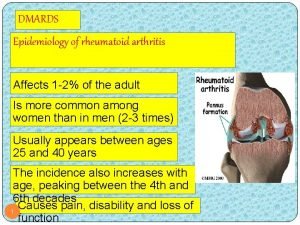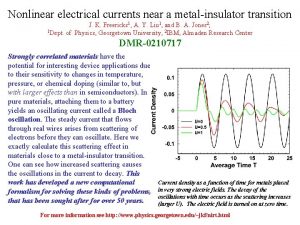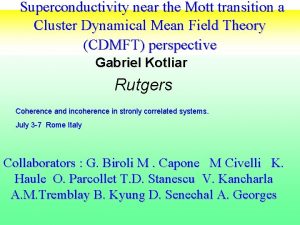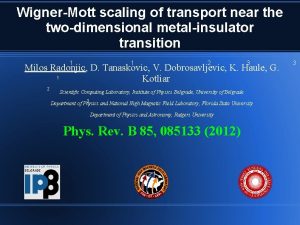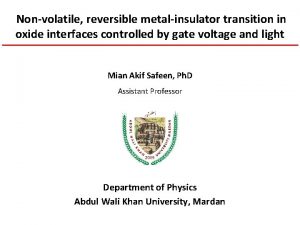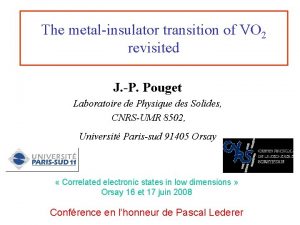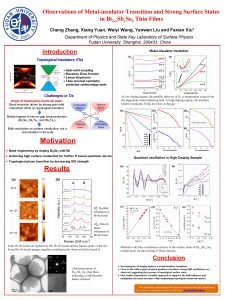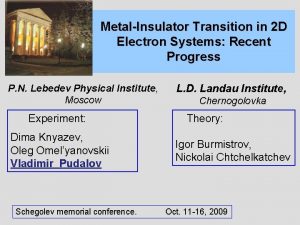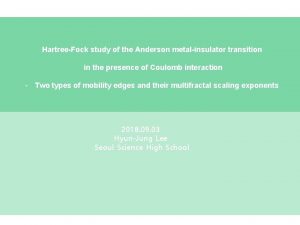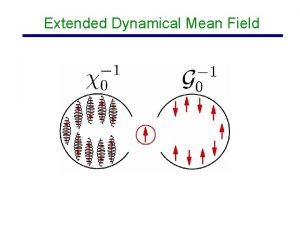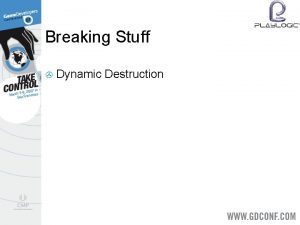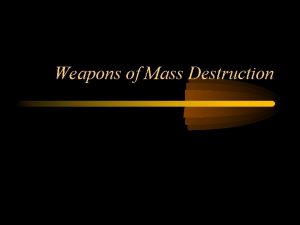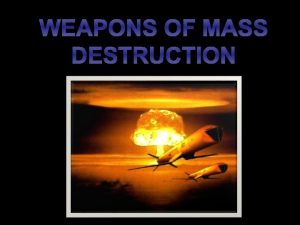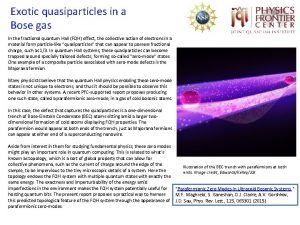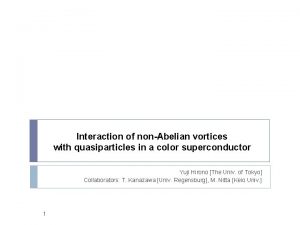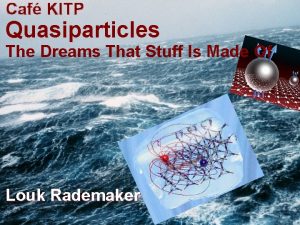Destruction of quasiparticles near the Mott metalinsulator transition
























![Phase diagram: �-ET 2 Cu[N(CN)2]Brx. Cl 1 -x Temperature vs. x X=0 X=1 metal Phase diagram: �-ET 2 Cu[N(CN)2]Brx. Cl 1 -x Temperature vs. x X=0 X=1 metal](https://slidetodoc.com/presentation_image_h2/67bc2d51b75f1012ea670b23f976e887/image-25.jpg)



















- Slides: 44

Destruction of quasi-particles near the Mott metal-insulator transition Ross Mc. Kenzie University of Queensland

Collaborators • Theory: Jaime Merino (Madrid) • Experiment: Michael Dumm Natalie Drichko Martin Dressel (Univ. Stuttgart) Ref: J. Merino et al. , Phys. Rev. Lett. 100, 0864040 (2008) For a review B. Powell & RHM, J. Phys. : Cond. Matt. 18, R 827 (2006).

Outline • Quasi-particles in quantum many-body systems • Mott metal-insulator transition • Frequency dependent optical conductivity as a probe of strong electronic correlations • Redistribution of spectral weight, Drude peak, sum rules • Half-filled layered organic superconductors near the bandwidth controlled Mott transition. • Dynamical mean-field theory gives a quantitative description of experiment.

• Why can we teach chemistry, solid state physics, and nuclear physics to undergraduates? • Why don’t they have to learn quantum many-body theory first!?

Chemical bonding in Nitrogen molecule Metallic crystal

Quasi-particles Landau’s great insight: Low energy excitations of strongly interacting quantum many-body systems can be understood in terms of weakly interacting collective excitations (quasi-particles). Usually the quasi-particles have the same quantum numbers and statistics as the constituent particles. But quasi-particle mass may be much larger than that of the constituent particles.

Quasi-particles Mattuck, A Guide to Feynman Diagrams

Quasi-particles • Do they always exist? • In strongly correlated electron systems the quantum numbers (e. g. , charge and spin) and statistics (fermion, boson, anyon) of quasi-particles can be different from those of constituent particles [RHM, Nature Physics 3, 756 (2007)]

Quasi-particle energy levels in a Fermi liquid metal

Drude model

Optical conductivity: elemental metals • Drude peak • Sum rule relates total spectral weight to plasma frequency and total charge density

Optical conductivity: elemental metals Frequency dependent dielectric constant of gold Agrees with Drude model from 50 cm-1 to 20, 000 cm-1 Weakly temperature dependent Ordal et al. , Applied Optics 22, 1099 (1983)

The Hubbard model metal U=0 Mott Transition U ~10 t insulator U=∞

Mott-Hubbard insulator If U >> |t|, insulator occurs for a half-filled band (average of one electron per lattice site). • Electrons are localised on individual lattice sites • Insulator because it is hard for charge to move thru system due to energy cost U associated with doubly occupied sites.

Mott metal-insulator transition BC=Bandwidth controlled FC=Filling controlled • Key question: what is the nature of the quasiparticles in the metallic phase, close to the Mott insulator

High-Tc superconductors are doped Mott insulators Changing the doping varies the band filling (the average number of electrons per site)

Key questions • In the metal are the quasi-particles fermions? i. e. , is it a Fermi liquid. • As the insulating phase is approached does the effective mass m* become very large, and/or does the number of charge carriers vanish?

Strong electronic correlations modify the optical conductivity • Reduce spectral weight in Drude peak • Transfer a large amount of spectral weight to high energies • Destroy Drude peak (and quasi-particles? ) above a relatively low temperature

Optical conductivity vs. frequency high-Tc superconductors Uchida et al. PRB 43, 792 (1991)

Optical conductivity vs. frequency Jonsson et al, PRL (2007)

Optical conductivity vs. frequency Iron oxypnictide La. Fe. PO Quazilbash et al, arxiv: 0808. 3748

Metallic ferromagnet, Ca. Ru. O 3 Kamal et al, PRB (2006)

Strong electronic correlations modify the optical conductivity • Reduce spectral weight in Drude peak • Transfer a large amount of spectral weight to high energies • Destroy Drude peak (and quasi-particles? ) above a relatively low temperature

Restricted f-sum rule Analogue of Thomas-Reiche-Kuhn sum rule in atomic spectroscopy In Hubbard model total spectral weight can be related to average kinetic energy
![Phase diagram ET 2 CuNCN2Brx Cl 1 x Temperature vs x X0 X1 metal Phase diagram: �-ET 2 Cu[N(CN)2]Brx. Cl 1 -x Temperature vs. x X=0 X=1 metal](https://slidetodoc.com/presentation_image_h2/67bc2d51b75f1012ea670b23f976e887/image-25.jpg)
Phase diagram: �-ET 2 Cu[N(CN)2]Brx. Cl 1 -x Temperature vs. x X=0 X=1 metal

Metal -------Insulator Faltermeier et al. PRB (2007)

Superconducting molecular charge transfer salts, β-ET 2 I 3 Sulphur Carbon Hydrogen Iodine

Minimal model for -(ET)2 X Hubbard model on anisotropic triangular lattice Each site corresponds to the bonding orbital of an ET dimer t t t’ J’ J J

Conductivity from dynamical meanfield theory (DMFT)

Strong correlations redistribute spectral weight

Subtract contributions of phonons and intra-dimer charge transfer excitations Faltermeier et al. , PRB (2007).

Experiment

Conductivity from dynamical meanfield theory (DMFT)

Extended Drude model gives frequency dependent scattering rate and effective mass

Scattering rate DMFT Experiment Effective mass

Qualitatively different to band filling controlled transition (cuprates) m* from optics does not change but n decreases at Mott insulator is approached Padilla et al. , PRB (2005)

Destruction of quasi-particles at “high” energies in heavy fermion compounds Scattering Rate Effective mass

Comparison of expt. and DMFT for resistivity vs. temperature P. Limelette et al. PRL 91, 016401 (2003)

Dynamical mean-field theory Kotliar and Vollhardt Physics Today July, 2004

Dynamical mean field theory • Solve Hubbard model by mapping onto an effective Anderson impurity model which is solved self consistently. • Treats local quantum dynamics exactly, but neglects spatial correlations. • Exact in infinite dimensions (or infinite lattice coordination number). • New insights into the Mott metal-insulator transition [Georges et al. Rev. Mod. Phys. (1996)]. • Predicts crossover from Fermi-liquid (coherent quasiparticles) to “bad metal” (quasi-localised electrons) behaviour as temperature increases.

Phase diagram: Temperature vs. U/t Hypercubic lattice at half-filling Mott-Hubbard metal-insulator transition

Conclusions • For the band-width controlled Mott transition the effective mass of quasi-particles increases as insulating phase is approached. • Fermi liquid quasi-particles are destroyed at “low energies” • Dynamical mean-field theory of the relevant Hubbard model gives a quantitative description of the redistribution of spectral weight due to strong electronic correlations. J. Merino et al. , Phys. Rev. Lett. 100, 0864040 (2008) B. Powell & RHM, J. Phys. : Cond. Matt. 18, R 827 (2006).

Comparison of cuprates & organics Changing the doping in the cuprates changes the filling (the average number of electrons per site) but leaves U>>t. Changing the pressure on the organics may change the ratio U/t [Mc. Kenzie, CCMP, 98] but it maintains half filling [Powell & Mc. Kenzie, JPCM, 04]

Why might DMFT be relevant to a 2 D triangular lattice? • DMFT is exact in the limit of infinite dimensions, but 2<<∞. • Frustration significantly reduces spatial correlations, enhancing the validity of a single site approximation. • For the antiferromagnetic Heisenberg model on a triangular lattice at T=J/3, the spin correlation length is about a one lattice constant versus 50 a for the square [Elstner et al. PRB ’ 93, JAP ‘ 94]. • Curie-Weiss law (which results from a local approximation) holds to a much lower T for triangular lattice than on square lattice [Zheng et al. PRB ’ 05].
 Mott transition
Mott transition Seahawks tackling drills
Seahawks tackling drills In quoits, what is the hob, the mott, or the pin?
In quoits, what is the hob, the mott, or the pin? Mott
Mott Kotliar
Kotliar Mott
Mott Serena mott
Serena mott Gurney mott theory
Gurney mott theory Cameron mott
Cameron mott Mott
Mott Mott
Mott Mott insulator
Mott insulator Enterotest
Enterotest Kim mott
Kim mott Mott
Mott Mott
Mott Mott
Mott Neural pruning ib psychology
Neural pruning ib psychology Mott insulator
Mott insulator Topological mott insulator
Topological mott insulator Mott
Mott Tableuu
Tableuu Mott polarimeter
Mott polarimeter Curva de mott
Curva de mott Mott
Mott Deasy destruction
Deasy destruction Things fall apart locusts
Things fall apart locusts Usps secure destruction
Usps secure destruction Destruction
Destruction Destruction
Destruction Destruction operator
Destruction operator Overexpansion and destruction of the alveoli
Overexpansion and destruction of the alveoli Destruction document honfleur
Destruction document honfleur Destruction of sennacherib
Destruction of sennacherib Bulbous bone contour
Bulbous bone contour Modern republicanism apush
Modern republicanism apush Widows peak perio
Widows peak perio Daisy destruction
Daisy destruction Sidney fishman
Sidney fishman Destruction of mankind
Destruction of mankind A haughty spirit
A haughty spirit Bulbous bone contour
Bulbous bone contour Joint destruction
Joint destruction 1962
1962 Destruction of mankind
Destruction of mankind
